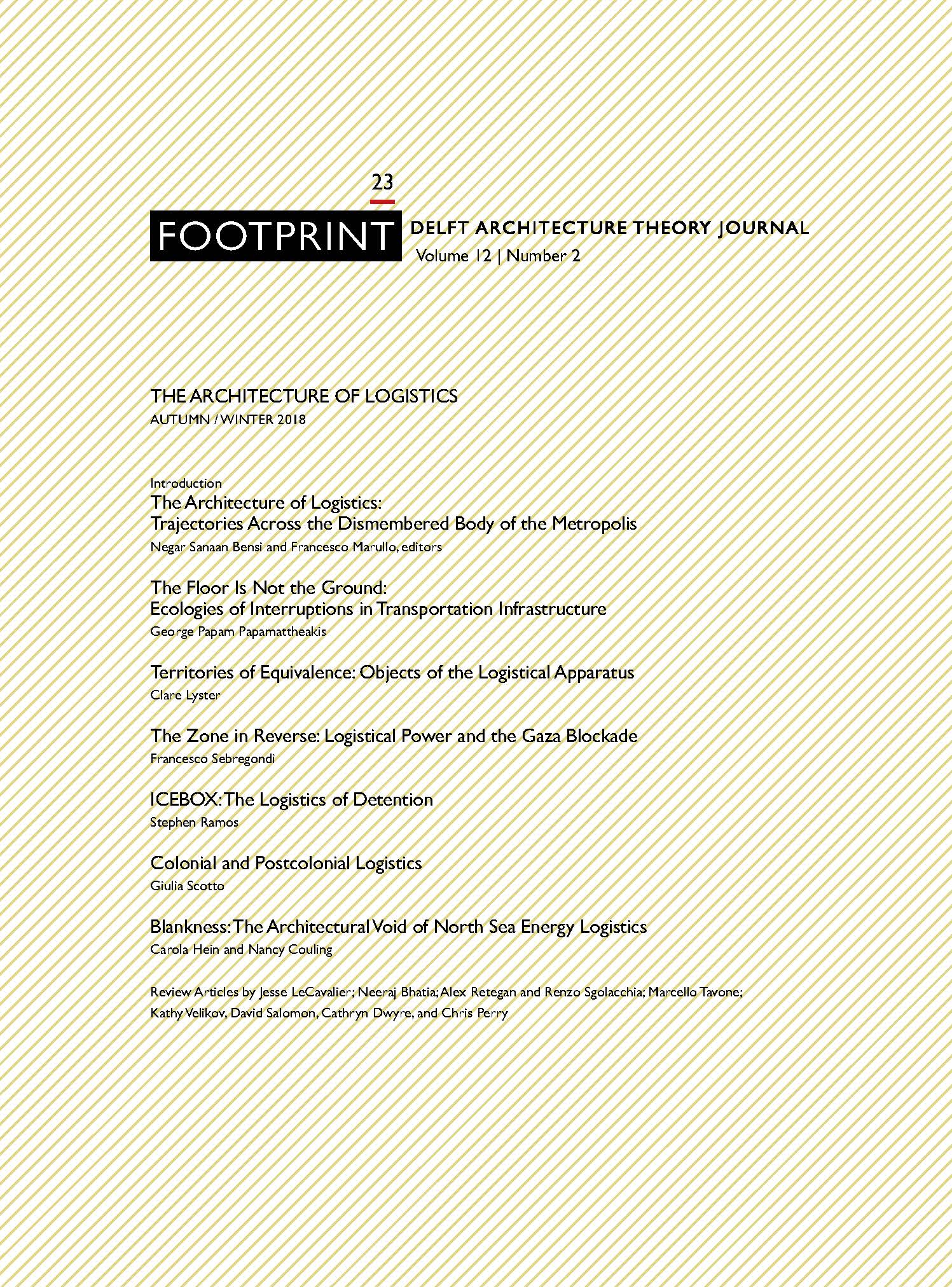The Floor is not the Ground
Ecologies of Interruptions in Transportation Infrastructure
DOI:
https://doi.org/10.7480/footprint.12.2.2040Abstract
Although transportation infrastructures occupy an important part of public space, they have apparently been lead astray by recent developments in logistics services. Despite the categorical difference between transportation and logistics, narratives of quality, security and standards accompanied by specific spatial patterns, have infiltrated our everyday mobility infrastructures. Space structure is defined by logistics-influenced ‘functional diagrams’ and is reduced to mere transitory settings. This essay is an effort to challenge the contemporary ‘fulfilment’-influenced, network-based perception of human transportation spaces, towards, instead, a relational, and effectively political, understanding of them. This is not to return to previous debates on the re-emergence of place and identity, but rather to seek possible strategies of interruption of that detrimental, endlessly intensified circulation imposed on public space. The essay is structured upon two competing ideas, conceptually represented by the notions of floor and ground. The floor is the most important element of logistics architecture, preparing a smooth surface for commodities circulation. By contrast, the ground embraces anomalies representing finitude, an important notion for the project of interruptions. The essay proposes a recalibration and balancing of both these forces, establishing an ecology that also encourages seemingly ‘unproductive’ relations, detours and other spaces of distractions, ideas that logistical architecture cannot even grasp.
References
Encyclopædia Britannica. 11th edition, Volume 10, Slice 5. Accessed online, http://www.gutenberg.org/files/35747/35747-h/35747-h.htm.
Adams, Ross Exo. To Fill the Earth: Circulation and Urbanization, MPhill diss., Birkbeck, 2014.
Alifragis, Dimitrios. The Soil: Genesis-Properties-Classification. Vol.1 Thessaloniki: Aivazis Press, 2008. (in Greek)
Augé, Marc. Non-places: Introduction to an Anthropology of Supermodernity. London: Verso, 1995.
Biggam, Carol P. ‘Grund to Hrof: Aspects of the Old English Semantics of Building and Architecture.’ Architectural History no. 45 (2002):49-65.
Booth, Barbara, Stephen D. Murphy, and Clarence J. Swanton. Weed Ecology in Natural and Agricultural Systems. Cambridge, MA: CABI Publishing, 2003.
Cacciari, Massimo. ‘Metropolis’, in Architecture and Nihilism: On the Philosophy of Modern Architecture. New Haven: Yale University Press, 1993.
Castells, Manuel. ‘Grassrooting The Space Of Flows.’ Urban Geography 20, no. 4 (1999): 294-302.
Castells, Manuel. The Rise of the Network Society. Oxford: Wiley-Blackwell, 2010.
Corner, James. ‘Terra Fluxus’, in Charles Waldheim ed., The Landscape Urbanism Reader. New York: Princeton Arch. Pr., 2006, 21-33.
Corner, James, and Alex S. MacLean. Taking Measures across the American Landscape. New Haven: Yale University Press, 1996.
Cowen, Deborah. The Deadly Life of Logistics: Mapping Violence in Global Trade. Minneapolis: University of Minnesota Press, 2014.
Dripps, Robin. ‘Groundwork’ in Burns, Carol, and Andrea Kahn, eds. Site Matters Design Concepts, Histories and Strategies. New York: Routledge, 2005, 59-92.
Easterling, Keller. Enduring Innocence: Global Architecture and Its Political Masquerades. Cambridge, MA: MIT, 2005.
Easterling, Keller. Extrastatecraft: The Power of Infrastructure Space. London: Verso, 2014.
Easterling, Keller. ‘Floor.dwg.’ Cabinet, no. 47 (2012): 98-101.
Elderfield, John. Imagining the Future of the Museum of Modern Art. New York: Museum of Modern Art, 1998.
Foufas, George, and George Papam. ‘Public Works of Infrastructure.’ Log, no. 39 (2017): 95-96.
Frey, Carl Benedikt, and Michael A. Osborne. ‘The future of employment: How susceptible are jobs to computerisation?’ Technological Forecasting and Social Change 114 (2017): 254-80.
Ghosn, Rania. ‘Move Along! There Is Nothing to See’ Thresholds MIT Journal 40 (2012): 33-38.
Hanley, Richard. ed., Moving People, Goods, and Information in the 21st Century. New York: Routledge, 2004.
Harvey, David. ‘Space as a Key Word’ in Spaces of Global Capitalism: Towards a Theory of Uneven Geographical Development. London: Verso, 2006, 117-148.
Higgins, Andrew. ‘China’s Ambitious New “Port”: Landlocked Kazakhstan.’ New York Times, January 1, 2018. https://www.nytimes.com.
Jetter, Clay, dir. ‘Dan Barber.’ In Chef's Table. Netflix. February 12, 2015.
Kotionis, Zissis. Multidomes: Multitude, Commons, and Architecture. Edited by Yorgos Tzirtzilakis. Volos: University of Thessaly Press, 2012.
Lay, Maxwell G. Ways of the World: A History of the Worlds Roads and of the Vehicles That Used Them. Sydney: Rutdgers University Press, 1992.
LeCavalier, Jesse. ‘The Restlessness of Objects.’ Cabinet, no. 47 (2012): 90-97.
Lines-Kelly, Rebecca. ‘Soil: Our Common Ground – a Humanities Perspective,’ proceedings of SuperSoil: 3rd Australian New Zealand Soils Conference, University of Sydney, 5-9 December 2004.
Lyster, Clare. Learning from Logistics: How Networks Change Our Cities. Basel, Berlin: Birkhäuser, 2016.
Mumford, Lewis. The City in History: Its Origins, Its Transformations, and Its Prospects. London: Secker & Warburg, 1961.
Naylor, Robert E. L. ‘What is a weed?’, in Naylor, Robert E. L. ed. Weed Management Handbook. Oxford: Published for the British Crop Protection Council by Blackwell Science, 2002, 1-15.
Online Etymology Dictionary. https://www.etymonline.com.
Oreopoulos, Filippos. ‘The Terrain.’ Proceedings of RR Radical Reading #1, Athens School of Fine Arts, Athens. 2016.
Rancière, Jacques. ‘Ten Thesis on Politics.’ Theory and Event 5, no. 3 (2001): 8.22.
Superstudio. Supersurface: An Alternative Model for Life on the Earth. Directed by Superstudio. Produced by
Marchi Producioni. New York: MoMa, 1972.
Tafuri, Manfredo. ‘Design and Technological Utopia’, in Ambasz, Emilio. Italy: The New Domestic Landscape; Achievements and Problems of Italian Design. New York: Distributed by New York Graphic Society, Greenwich, Conn., 1972.
Toscano, Alberto. ‘Logistics and Opposition.’ Mute, August 9, 2011. http://www.metamute.org.
Downloads
Published
Issue
Section
License
- Authors retain copyright and grant the journal right of first publication with the work simultaneously licensed under a Creative Commons Attribution License that allows others to share the work with an acknowledgement of the work's authorship and initial publication in this journal.
- Authors are able to enter into separate, additional contractual arrangements for the non-exclusive distribution of the journal's published version of the work (e.g., post it to an institutional repository or publish it in a book), with an acknowledgement of its initial publication in this journal.





